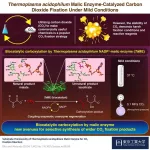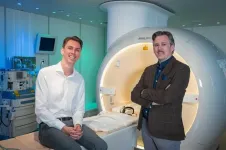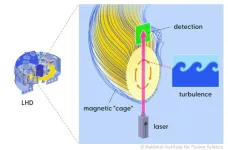(Press-News.org) Around two million years ago, Earth was a very different place, with our early human ancestors living alongside saber-toothed tigers, mastodons, and enormous rodents. And, depending on where they were, they may have been cold: Earth had fallen into a deep freeze, with multiple ice ages coming and going until about 12,000 years ago. Scientists theorize that ice ages occur for a number of reasons, including the planet’s tilt and rotation, shifting plate tectonics, volcanic eruptions, and carbon dioxide levels in the atmosphere. But what if drastic changes like these are not only a result of Earth’s environment, but also the sun’s location in the galaxy?
In a new paper published in Nature Astronomy, lead author and astrophysicist Merav Opher—an astronomy professor at Boston University and fellow at Harvard Radcliffe Institute— found evidence that some two million years ago, the solar system encountered an interstellar cloud so dense that it could have interfered with the sun’s solar wind. Opher and her co-authors believe this shows that the sun’s location in space might shape Earth’s history more than previously considered.
Our whole solar system is swathed in a protective plasma shield that emanates from the sun, known as the heliosphere. It’s made from a constant flow of charged particles, called solar wind, that stretch well past Pluto, wrapping the planets in what NASA calls a “a giant bubble.” It protects us from radiation and galactic rays that could alter DNA, and scientists believe it’s part of the reason life evolved on Earth as it did. According to the latest paper, the cold cloud compressed the heliosphere in such a way that it briefly placed Earth and the other planets in the solar system outside of the heliosphere’s influence.
“This paper is the first to quantitatively show there was an encounter between the sun and something outside of the solar system that would have affected Earth’s climate,” says Opher, who is an expert on the heliosphere. Her models have quite literally shaped our scientific understanding of the heliosphere, and how the bubble is structured by the solar wind pushing up against the interstellar medium—which is the space in between stars and beyond the heliosphere in our galaxy. Her theory is that the heliosphere is shaped like a puffy croissant, an idea that shook the space physics community. Now, she’s shedding new light on how the heliosphere, and where the sun moves through space, could affect Earth’s atmospheric chemistry.
“Stars move, and now this paper is showing not only that they move, but they encounter drastic changes,” says Opher. She first discovered and began working on this study during a yearlong fellowship at Harvard Radcliffe Institute.
To study this phenomenon, Opher and her collaborators essentially looked back in time, using sophisticated computer models to visualize where the sun was positioned two million years in the past—and, with it, the heliosphere, and the rest of the solar system. They also mapped the path of the Local Ribbon of Cold Clouds system, a string of large, dense, very cold clouds mostly made of hydrogen atoms. Their simulations showed that one of the clouds close to the end of that ribbon, named the Local Lynx of Cold Cloud, could have collided with the heliosphere.
If that had happened, says Opher, Earth would have been fully exposed to the interstellar medium, where gas and dust mix with the leftover atomic elements of exploded stars, including iron and plutonium. Normally, the heliosphere filters out most of these radioactive particles. But without protection, they can easily reach Earth. According to the paper, this aligns with geological evidence that shows increased 60Fe (iron 60) and 244Pu (plutonium 244) isotopes in the ocean, on the moon, Antarctic snow, and ice cores from the same time period. The timing also matches with temperature records that indicate a cooling period.
“Only rarely does our cosmic neighborhood beyond the solar system affect life on Earth,” says Avi Loeb, director of Harvard University’s Institute for Theory and Computation and coauthor on the paper. “It is exciting to discover that our passage through dense clouds a few million years ago could have exposed the Earth to a much larger flux of cosmic rays and hydrogen atoms. Our results open a new window into the relationship between the evolution of life on Earth and our cosmic neighborhood.”
The outside pressure from the Local Lynx of Cold Cloud could have continually blocked out the heliosphere for a couple of hundred years to a million years, Opher says—depending on the size of the cloud. “But as soon as the Earth was away from the cold cloud, the heliosphere engulfed all the planets, including Earth,” she says. And that’s how it is today.
It’s impossible to know the exact effect the cold clouds had on Earth—like if it could have spurred an ice age. But there are a couple of other cold clouds in the interstellar medium that the sun has likely encountered in the billions of years since it was born, Opher says. And it will likely stumble across more in another million years or so. Opher and her collaborators are now working to trace where the sun was seven million years ago, and even further back. Pinpointing the location of the sun millions of years in the past, as well as the cold cloud system, is possible with data collected by the European Space Agency’s Gaia mission, which is building the largest 3D map of the galaxy and giving an unprecedented look at the speed stars move.
“This cloud was indeed in our past, and if we crossed something that massive, we were exposed to the interstellar medium,” Opher says. The effect of crossing paths with so much hydrogen and radioactive material is unclear, so Opher and her team at BU’s NASA-funded SHIELD (Solar wind with Hydrogen Ion Exchange and Large-scale Dynamics) DRIVE Science Center are now exploring the effect it could have had on Earth’s radiation, as well as the atmosphere and climate.
“This is only the beginning,” Opher says. She hopes that this paper will open the door to much more exploration of how the solar system was influenced by outside forces in the deep past and how these forces have in turn shaped life on our planet.
This research was supported by NASA.
Republishers are kindly reminded to uphold journalistic integrity by providing proper crediting, including a direct link back to the original source URL.
END
The solar system may have passed through dense interstellar clouds 2 million years ago, altering Earth’s climate
Astrophysicists calculate the likelihood that Earth was exposed to cold, harsh interstellar clouds, a phenomenon not previously considered in geologic climate models
2024-06-10
ELSE PRESS RELEASES FROM THIS DATE:
Miniaturizing a laser on a photonic chip
2024-06-10
Lasers have revolutionized the world since the 60’s and are now indispensable in modern applications, from cutting-edge surgery and precise manufacturing to data transmission across optical fibers.
But as the need for laser-based applications grows, so do challenges. For example, there is a growing market for fiber lasers, which are currently used in industrial cutting, welding, and marking applications.
Fiber lasers use an optical fiber doped with rare-earth elements (erbium, ytterbium, neodymium etc) as their optical gain source (the part that produces the laser’s light). They emit high-quality beams, they have high power output, and they are efficient, ...
Study: Physical activity in the evening lowers blood sugar levels
2024-06-10
ROCKVILLE, Md.— New research reveals that moderate to vigorous physical activity in the evening for sedentary adults with overweight and obesity is most beneficial in lowering daily blood sugar levels, according to a study published in Obesity, The Obesity Society’s (TOS) flagship journal.
Experts explain that it has been well established that moderate to vigorous physical activity enhances glucose homeostasis in adults with overweight and obesity who are at higher risk of developing insulin resistance. ...
Experts develop nutritional recommendations for patients treated with anti-obesity medications
2024-06-10
ROCKVILLE, Md.— Individuals treated with anti-obesity medications generally experience reduced appetite, which typically leads to reduced food intake. As a result, dietary quality becomes more important because nutritional needs must be met within the context of eating less. To improve this process, medical experts have developed a list of evidence-based nutritional recommendations to assist clinicians treating patients with anti-obesity medications, according to a review published in the journal Obesity, The Obesity Society’s (TOS) flagship journal.
“Our evidence-based review aims to equip clinicians with knowledge ...
Peers crucial in shaping boys’ confidence in math skills
2024-06-10
Boys are good at math, girls not so much? A study from the University of Zurich has analyzed the social mechanisms that contribute to the gender gap in math confidence. While peer comparisons seem to play a crucial role for boys, girls’ subjective evaluations are more likely to be based on objective performance.
Research has shown that in Western societies, the average secondary school girl has less confidence in her mathematical abilities than the average boy of the same age. At the same time, no significant difference ...
Fixing excess carbon dioxide: biocatalyst-driven carboxylation under mild conditions
2024-06-10
Carbon capture and utilization technologies for the conversion of carbon dioxide into carboxylic acids have garnered attention recently, with researchers from Tokyo Tech recently demonstrating a biocatalyzed carboxylation reaction of not only natural substrate, pyruvate, but also unnatural one, 2-ketoglutarate, using Thermoplasma acidophilum NADP+- malic enzyme under mild reaction conditions. The proposed strategy can be tailored for the selective synthesis through carbon dioxide fixation reactions.
Removing the excess carbon dioxide (CO2) from the environment is not the end goal of the decarbonization process necessary to ...
Lung cancer screening prolongs lives in real-world study
2024-06-10
Among US veterans diagnosed with lung cancer through the Veterans Health Administration healthcare system, those who underwent screening before diagnosis were more likely to be diagnosed with earlier stage disease and had a higher cure rate than those who had not been screened. The findings come from an observational study published by Wiley online in CANCER, a peer-reviewed journal of the American Cancer Society.
Lung cancer is the leading cause of cancer deaths worldwide, and most patients are diagnosed at ...
New study reveals links between social anxiety, depression and suicidal thoughts in adolescents
2024-06-10
Peer-reviewed – Observational study - People
Adolescents who experience higher levels of social anxiety symptoms are more likely to report increased suicidal thoughts and other depressive symptoms two years later, according to new research.
The University of East Anglia-led study sheds light on the pressing need for early interventions to address society anxiety in young people.
Lead author Dr Kenny Chiu, Clinical Lecturer in Clinical Psychology at UEA’s Department of Clinical Psychology and Psychological Therapies, said: “Social Anxiety Disorder ...
Disturbed blood flow can damage the vessel wall in cases of aortic dilation
2024-06-10
Abnormal blood flow in the aorta is linked to inflammation and breakdown of the vessel wall in conditions where the aorta is dilated. This is shown in a study led by researchers at Linköping University. The findings can contribute to better diagnosis and open up new ways to assess the risk of serious and usually fatal complications, such as rupture of the aorta.
All blood in the body passes through the heart about once a minute. With every heartbeat, blood from the heart is pumped up into the aorta.
Dilation can occur in all parts ...
Psychosocial skills can stop relapse in people with eating disorders, says expert
2024-06-10
Health services should teach patients with eating disorders psychosocial skills to help more people recover and avoid relapse, according to an expert.
Anorexia, bulimia and other eating issues affect millions of people, and eating disorder specialist Bethany Crowley warns that eating disorders are often misunderstood. She suggests a more integrated approach to treating people is needed, to focus on the whole person rather than just the disordered eating.
Quieting negative thoughts, learning to cope with emotional triggers and practicing self-compassion are among nine key skills outlined by the therapist in a new book.
An Integrative Approach to Treating Eating ...
The discovery of new turbulence transition in fusion plasmas
2024-06-10
Background
Fusion energy is that released when two light nuclei combine to form a single heavier one (nuclear fusion reaction). Fusion energy-based power generation (fusion power plant) uses the energy generated when deuterium and tritium combine to form helium. A nuclear fusion reaction does not produce carbon dioxide. In addition, since it is possible to extract deuterium and tritium from the sea water, fusion energy is regarded as a sustainable energy source, and research into its practical application has been progressing rapidly ...
LAST 30 PRESS RELEASES:
UVA’s Jundong Li wins ICDM’S 2025 Tao Li Award for data mining, machine learning
UVA’s low-power, high-performance computer power player Mircea Stan earns National Academy of Inventors fellowship
Not playing by the rules: USU researcher explores filamentous algae dynamics in rivers
Do our body clocks influence our risk of dementia?
Anthropologists offer new evidence of bipedalism in long-debated fossil discovery
Safer receipt paper from wood
Dosage-sensitive genes suggest no whole-genome duplications in ancestral angiosperm
First ancient human herpesvirus genomes document their deep history with humans
Why Some Bacteria Survive Antibiotics and How to Stop Them - New study reveals that bacteria can survive antibiotic treatment through two fundamentally different “shutdown modes”
UCLA study links scar healing to dangerous placenta condition
CHANGE-seq-BE finds off-target changes in the genome from base editors
The Journal of Nuclear Medicine Ahead-of-Print Tip Sheet: January 2, 2026
Delayed or absent first dose of measles, mumps, and rubella vaccination
Trends in US preterm birth rates by household income and race and ethnicity
Study identifies potential biomarker linked to progression and brain inflammation in multiple sclerosis
Many mothers in Norway do not show up for postnatal check-ups
Researchers want to find out why quick clay is so unstable
Superradiant spins show teamwork at the quantum scale
Cleveland Clinic Research links tumor bacteria to immunotherapy resistance in head and neck cancer
First Editorial of 2026: Resisting AI slop
Joint ground- and space-based observations reveal Saturn-mass rogue planet
Inheritable genetic variant offers protection against blood cancer risk and progression
Pigs settled Pacific islands alongside early human voyagers
A Coral reef’s daily pulse reshapes microbes in surrounding waters
EAST Tokamak experiments exceed plasma density limit, offering new approach to fusion ignition
Groundbreaking discovery reveals Africa’s oldest cremation pyre and complex ritual practices
First breathing ‘lung-on-chip’ developed using genetically identical cells
How people moved pigs across the Pacific
Interaction of climate change and human activity and its impact on plant diversity in Qinghai-Tibet plateau
From addressing uncertainty to national strategy: an interpretation of Professor Lim Siong Guan’s views
[Press-News.org] The solar system may have passed through dense interstellar clouds 2 million years ago, altering Earth’s climateAstrophysicists calculate the likelihood that Earth was exposed to cold, harsh interstellar clouds, a phenomenon not previously considered in geologic climate models



